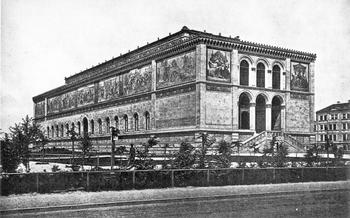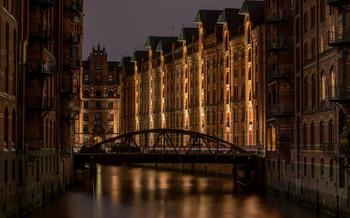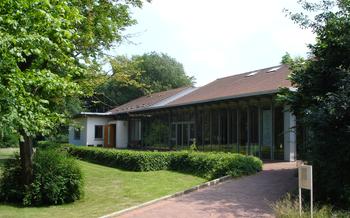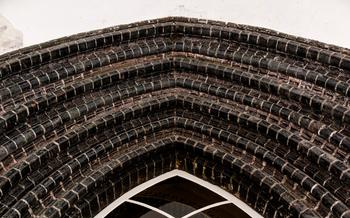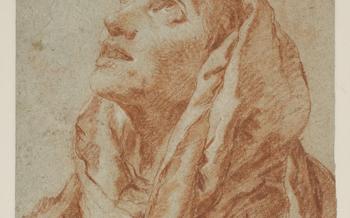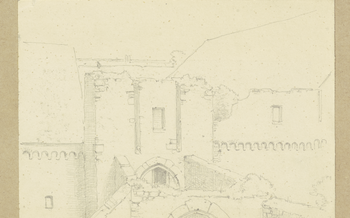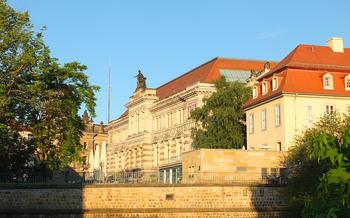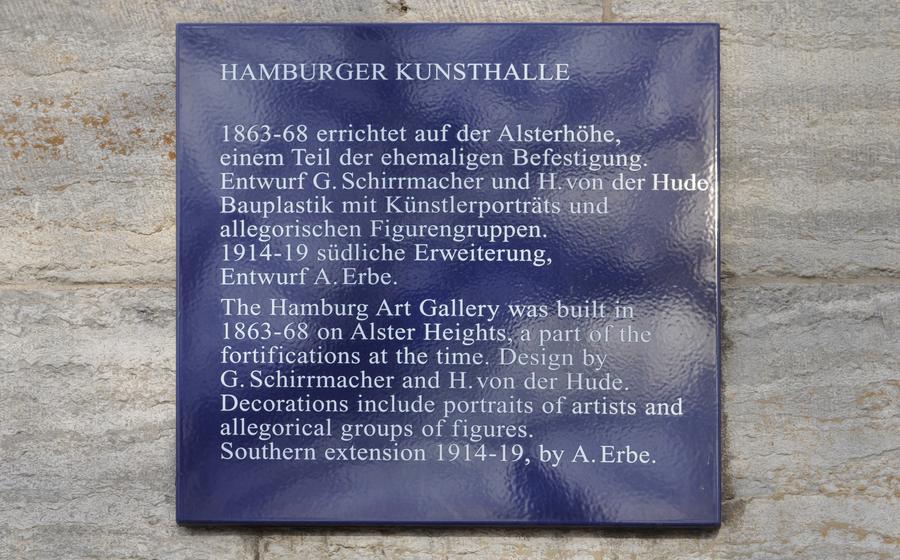
Hamburger Kunsthalle
- The Hamburger Kunsthalle: A Masterpiece of Art and Architecture
- Historical significance
- A Journey Through Art History: From Medieval to Contemporary
- Old Masters and Renaissance Treasures
- 19th-Century Romanticism and Realism
- Impressionism and Post-Impressionism: Capturing Light and Emotion
- Expressionism: A Revolution in Art
- Modern and Contemporary Art: Pushing Boundaries
- Special Exhibitions and Events: A Dynamic Art Scene
- The Building: A Work of Art in Itself
- Guided Tours and Audio Guides: Enhancing Your Visit
- Museum Shop and Café: Souvenirs and Refreshments
- Accessibility and Facilities: Ensuring Inclusivity
- Planning Your Visit: Tips for a Smooth Experience
- Nearby Attractions and Cultural Hotspots
- Insider Tip: Unveiling Hidden Gems
The Hamburger Kunsthalle: A Masterpiece of Art and Architecture
A journey through the annals of art and culture awaits visitors to the Hamburger Kunsthalle, a venerable institution renowned for its exceptional collection and architectural splendor. Founded in 1850, this prestigious museum stands as a testament to Hamburg's rich artistic heritage and its enduring commitment to preserving and showcasing masterpieces from across the ages.
Situated in the heart of Hamburg's Neustadt district, the Hamburger Kunsthalle boasts a prime location, easily accessible by public transportation or on foot. Its imposing neo-Renaissance façade, adorned with intricate sculptures and decorative elements, hints at the treasures that lie within. Step inside, and prepare to be captivated by a world of artistic wonders, spanning from medieval masterpieces to groundbreaking contemporary creations.
Historical significance
The Hamburger Kunsthalle holds a significant place in the annals of art history. Founded in the mid-19th century, when Hamburg was a thriving port city and a major player in the art trade, the museum quickly established itself as a prominent institution. It played a crucial role in shaping the city's cultural identity and fostering a vibrant artistic community. Over the years, the Kunsthalle has undergone several expansions and renovations, each reflecting the changing tastes and trends in the art world. Today, it stands as a testament to Hamburg's enduring commitment to preserving and showcasing artistic heritage.
A Journey Through Art History: From Medieval to Contemporary
The Hamburger Kunsthalle boasts a comprehensive collection that spans a wide range of art periods, from medieval masterpieces to cutting-edge contemporary works. Embark on a journey through art history as you explore the museum's diverse galleries.
In the medieval section, marvel at exquisite Gothic altarpieces and sculptures that showcase the artistry of the period. Don't miss the 14th-century "Madonna and Child" by Master Bertram, a stunning example of the Northern Gothic style.
Moving on to the Renaissance, admire paintings by some of the most renowned masters of the era, including Albrecht Dürer, Lucas Cranach the Elder, and Hans Holbein the Younger. Their works capture the essence of the Renaissance, with their meticulous attention to detail and vibrant colors.
The 19th century is represented by a rich collection of Romantic and Realist paintings. Caspar David Friedrich's haunting landscapes evoke a sense of awe and wonder, while Adolph Menzel's realistic depictions of everyday life offer a glimpse into the social and cultural changes of the time.
Impressionism and Post-Impressionism are well-represented, with stunning works by Claude Monet, Pierre-Auguste Renoir, Edgar Degas, and Paul Cézanne. Their vibrant brushstrokes and innovative use of color capture the essence of the movement, while also highlighting the influence of French art on German artists.
The early 20th century witnessed the rise of Expressionism, a powerful and emotional movement that challenged traditional artistic conventions. Works by Ernst Ludwig Kirchner, Erich Heckel, and Emil Nolde showcase the bold colors and distorted forms that characterized Expressionism.
Old Masters and Renaissance Treasures
The Hamburger Kunsthalle is home to a remarkable collection of old master paintings and sculptures from the 14th to 17th centuries. These works offer a glimpse into the artistic and cultural heritage of Germany and Europe during this transformative period.
Among the highlights of the collection are masterpieces by Albrecht Dürer, one of the most renowned artists of the German Renaissance. His famous painting "Portrait of a Young Man" captivates with its intricate detail and profound psychological insight. Another highlight is the stunning "Venus and Cupid" by Lucas Cranach the Elder, showcasing the artist's mastery of color and composition.
The museum also houses a significant collection of works by Hans Holbein the Younger, including his iconic "Portrait of Erasmus of Rotterdam." This painting is celebrated for its realistic depiction of the great humanist scholar, capturing his intelligence and determination.
Beyond paintings, the Kunsthalle boasts an impressive array of sculptures and decorative arts from the Renaissance period. These works demonstrate the exquisite craftsmanship and artistic virtuosity of the era. Visitors can admire intricate wood carvings, delicate ivories, and finely crafted metalwork.
The influence of the Hanseatic League, a powerful trading alliance that dominated Northern Europe during the Middle Ages, is also evident in the collection. Paintings depicting ships and bustling harbors, as well as portraits of wealthy merchants, reflect the economic and cultural importance of the Hanseatic League in Hamburg's history.
19th-Century Romanticism and Realism
The 19th century witnessed the rise of Romanticism and Realism in art, and the Hamburger Kunsthalle boasts a remarkable collection from this period. Romanticism, with its emphasis on emotion, imagination, and the individual, is represented by stunning landscapes, portraits, and genre paintings. Caspar David Friedrich's iconic "The Wanderer above the Sea of Fog" epitomizes this movement, capturing the sublime beauty of nature and the introspective nature of the human spirit.
Adolph Menzel, on the other hand, was a master of Realism, capturing the everyday life and social realities of his time. His paintings, such as "The Iron Rolling Mill," offer a glimpse into the industrial transformation of the 19th century. The influence of the Barbizon School, a group of French landscape painters, can also be seen in the works of German artists during this period, leading to a new appreciation for the beauty of the natural world.
Social and political themes also found their way into art, reflecting the tumultuous times of the 19th century. Paintings depicting scenes of poverty, social injustice, and political unrest highlighted the challenges faced by society. The Hamburger Kunsthalle's collection from this period offers a comprehensive overview of the artistic movements and social changes that shaped the 19th century.
Impressionism and Post-Impressionism: Capturing Light and Emotion
The Hamburger Kunsthalle houses a significant collection of Impressionist and Post-Impressionist paintings, offering visitors a glimpse into the transformative art movements of the late 19th and early 20th centuries. These works capture the essence of light, color, and emotion, forever changing the course of art history.
Among the highlights of the collection are stunning works by Claude Monet, whose vibrant landscapes and shimmering water scenes epitomize the Impressionist style. Visitors can marvel at his "Impression, Sunrise," which gave the movement its name, as well as other masterpieces such as "Water Lilies" and "Rouen Cathedral."
The Post-Impressionist movement, represented by artists like Pierre-Auguste Renoir, Edgar Degas, and Paul Cézanne, pushed the boundaries of Impressionism, exploring new techniques and perspectives. Renoir's enchanting portraits and scenes of Parisian life, Degas's graceful dancers, and Cézanne's groundbreaking geometric compositions offer a diverse and compelling look at this revolutionary period in art.
The influence of French art on German artists during this time cannot be overstated. German Impressionists like Max Liebermann and Lovis Corinth drew inspiration from their French counterparts, incorporating similar techniques and themes into their own work. This cross-cultural exchange resulted in a vibrant and dynamic art scene in Germany, contributing to the development of modern art as a whole.
Expressionism: A Revolution in Art
The Hamburger Kunsthalle is home to a remarkable collection of Expressionist art, a movement that emerged in Germany in the early 20th century and revolutionized the art world. Powerful and emotionally charged, Expressionist works sought to convey inner feelings and subjective experiences rather than depicting objective reality.
Among the highlights of the Kunsthalle's Expressionist collection are works by Ernst Ludwig Kirchner, Erich Heckel, and Emil Nolde, three of the Brücke group's founding members, a collective of Expressionist artists. Their bold colors, distorted forms, and raw emotions captured the turmoil and anxieties of a society on the brink of war.
The Blaue Reiter movement, another influential Expressionist group, is also well-represented at the Kunsthalle. Works by Wassily Kandinsky, Franz Marc, and August Macke showcase their exploration of abstraction, symbolism, and spirituality. Their colorful and dreamlike compositions sought to evoke a sense of transcendence and inner harmony.
The Kunsthalle's Expressionist collection offers a comprehensive overview of this groundbreaking movement, providing insights into the social, political, and cultural upheavals that shaped the early 20th century. It's a must-see for anyone interested in the history of modern art and the enduring legacy of Expressionism.
Modern and Contemporary Art: Pushing Boundaries
The Hamburger Kunsthalle is not only home to old masters and historical treasures but also boasts an impressive collection of modern and contemporary art. Here, visitors can explore the innovative and thought-provoking works of the 20th and 21st centuries, challenging traditional notions of art and pushing the boundaries of artistic expression.
Among the highlights of the collection are works by Anselm Kiefer, a German artist known for his large-scale paintings that incorporate elements of history, mythology, and personal experience. Gerhard Richter, another renowned German artist, is represented with his distinctive photo-based paintings that blur the lines between photography and painting. Wolfgang Tillmans, a contemporary German photographer, presents works that explore themes of identity, sexuality, and the nature of the image.
The museum's collection of modern and contemporary art also includes installations, sculptures, and multimedia art, showcasing the diversity and dynamism of contemporary artistic practices. These works often engage with social, political, and environmental issues, inviting viewers to reflect on the complexities of the modern world.
The Hamburger Kunsthalle's commitment to modern and contemporary art reflects its forward-looking vision and its role as a vibrant center for artistic innovation. This section of the museum offers visitors a glimpse into the cutting-edge trends and ideas that are shaping the art world today.
Special Exhibitions and Events: A Dynamic Art Scene
The Hamburger Kunsthalle is not just a repository of historic treasures; it is also a vibrant and dynamic center of contemporary art. The museum regularly hosts special exhibitions showcasing the works of international artists, both established and emerging. These exhibitions often explore cutting-edge themes and trends, providing visitors with a glimpse into the latest developments in the art world.
Collaborations with other institutions and artists bring fresh perspectives and innovative approaches to the museum's programming. Thematic displays and installations challenge traditional notions of art and engage visitors in thought-provoking dialogues. Lectures, workshops, and performances further enhance the museum's dynamic atmosphere, creating a space for artistic exchange and exploration.
Whether you are an art enthusiast, a casual visitor, or simply seeking a unique cultural experience, the Hamburger Kunsthalle's special exhibitions and events offer something for everyone. Embrace the opportunity to immerse yourself in the world of contemporary art and discover new artistic voices that will challenge your perceptions and leave a lasting impression.
The Building: A Work of Art in Itself
Beyond its impressive collection, the Hamburger Kunsthalle is also a masterpiece of architecture. The original building, constructed in 1869, was designed by the renowned German architect Martin Haller in the Neo-Renaissance style. Its grand façade features intricate carvings, arched windows, and a monumental entrance, reflecting the cultural significance of the institution.
Over the years, the museum has undergone several expansions and renovations to accommodate its growing collection and evolving needs. In 1921, a new wing was added, designed by Fritz Schumacher, a prominent architect of the Hamburg School. This wing features a more modern and functional design, with large windows that flood the interior with natural light.
In 1997, the museum underwent a major renovation and expansion project led by the renowned architect Oswald Mathias Ungers. This project involved the construction of a new wing, known as the Galerie der Gegenwart (Gallery of Contemporary Art). The Galerie der Gegenwart is a striking example of contemporary architecture, featuring a minimalist design with clean lines, glass facades, and open spaces.
The combination of historical and modern architecture creates a unique and harmonious ensemble that reflects the museum's commitment to preserving its heritage while embracing contemporary trends. The Hamburger Kunsthalle's building is not just a container for art but a work of art in its own right, adding to the overall experience of visiting this cultural treasure.
Guided Tours and Audio Guides: Enhancing Your Visit
To make the most of your visit to the Hamburger Kunsthalle, consider taking advantage of the guided tours and audio guides offered by the museum. Guided tours are available in various languages, including English, German, and Spanish, and are led by knowledgeable and experienced art historians. These tours provide in-depth insights into the museum's collection, highlighting key works and offering historical and cultural context.
Thematic tours are also available, focusing on specific collections or artists. For example, you can take a tour dedicated to the Old Masters, the Impressionists, or the Expressionists, allowing you to delve deeper into these influential art movements.
For those who prefer a more self-guided experience, the museum offers audio guides that provide commentary on selected works throughout the collection. The audio guides are available in multiple languages and can be rented at the museum's information desk.
Whether you choose a guided tour or an audio guide, these resources will enhance your visit to the Hamburger Kunsthalle, helping you to understand and appreciate the artworks on display.
Museum Shop and Café: Souvenirs and Refreshments
After immersing yourself in the world of art, you might want to take a break and browse the museum shop for unique souvenirs and gifts inspired by the museum's collection. From books and prints to postcards and replicas of famous artworks, you'll find a treasure trove of items to commemorate your visit.
The museum café offers a delightful respite where you can relax and reflect on your art-filled experience. Enjoy a cup of coffee or tea, accompanied by a light snack or pastry, as you soak in the museum's ambiance. The café provides a cozy and inviting space to unwind and contemplate the masterpieces you've seen.
Accessibility and Facilities: Ensuring Inclusivity
The Hamburger Kunsthalle is committed to providing an accessible and welcoming environment for all visitors. Wheelchair users and visitors with impaired mobility can easily navigate the museum's spaces with designated parking areas and ramps. Assisted listening devices are available for the hearing impaired, ensuring they can fully engage with the audio guides and guided tours. Family-friendly facilities, including baby changing rooms and strollers, make it easy for parents to explore the museum with their young ones. The museum's commitment to inclusivity extends to its educational programs, with workshops and activities designed to cater to diverse learning styles and needs. By creating a welcoming and accessible environment, the Hamburger Kunsthalle ensures that everyone can enjoy and appreciate the treasures within its walls.
Planning Your Visit: Tips for a Smooth Experience
To make the most of your visit to the Hamburger Kunsthalle, careful planning is essential. Advance ticket purchase is highly recommended, especially during peak tourist seasons, to avoid long queues. The museum's online reservation system allows you to secure your spot and choose a preferred time slot.
Before your visit, take some time to explore the museum's website. It provides up-to-date information on current exhibitions, events, and any temporary closures or changes in operating hours. This will help you tailor your visit to your specific interests.
When visiting the Hamburger Kunsthalle, allocate ample time to fully appreciate the extensive collection. The museum houses over 86,000 artworks, spanning various periods and styles. Allow at least two to three hours to thoroughly explore the highlights and delve into the stories behind the masterpieces.
Guided tours are an excellent way to gain deeper insights into the museum's collection. Led by knowledgeable art historians, these tours provide expert commentary and anecdotes, enhancing your understanding and appreciation of the artworks. Various tours are available, focusing on specific collections, artists, or themes.
Remember to check the museum's website regularly for updates on special exhibitions, events, and educational programs. The Hamburger Kunsthalle frequently hosts temporary exhibitions featuring renowned international artists, thematic displays, lectures, workshops, and performances. These events offer a dynamic and engaging experience, allowing you to delve deeper into the world of art and culture.
Nearby Attractions and Cultural Hotspots
The Hamburger Kunsthalle is nestled in the heart of Hamburg's vibrant Neustadt district, a treasure trove of cultural attractions. Take a leisurely stroll through the charming streets, lined with independent boutiques, art galleries, and cozy cafés. Explore the Kunsthalle's satellite galleries, such as the Galerie der Gegenwart, showcasing contemporary art, and the Deichtorhallen, a former warehouse transformed into a vibrant exhibition space.
Hamburg offers a rich cultural landscape beyond the Kunsthalle. Stroll along the picturesque Alster Lake, a serene oasis in the city center, and admire the stunning views of the cityscape. Visit the nearby Museum für Kunst und Gewerbe, renowned for its collection of decorative arts and design, or immerse yourself in the world of photography at the Museum für Photographie. Hamburg is a city that pulsates with creativity, offering a diverse range of cultural experiences for every taste.
Insider Tip: Unveiling Hidden Gems
Beyond the renowned masterpieces, the Hamburger Kunsthalle holds a treasure trove of lesser-known works that offer a unique glimpse into the museum's diverse collection. Take the time to explore the nooks and crannies of the galleries, where you might stumble upon forgotten gems or discover new favorites.
The museum's archives and research facilities are a treasure trove for art enthusiasts. Here, you can access a wealth of information, including sketches, studies, and documents that shed light on the creative process of the featured artists. Guided tours often provide exclusive insights into these hidden treasures, offering a deeper understanding of the museum's collection.
Throughout the year, the Hamburger Kunsthalle hosts special workshops, lectures, and events that delve into specific themes or techniques. These programs offer a unique opportunity to engage with experts, learn from practicing artists, and gain a deeper appreciation for the museum's collection.
Finally, take the time to uncover the stories behind the masterpieces. Each artwork has its own unique history, from its creation to its acquisition by the museum. Guided tours and audio guides often provide fascinating anecdotes and insights into the lives of the artists and the significance of their works. By exploring these hidden gems and delving into the stories behind the scenes, you'll gain a richer and more meaningful understanding of the Hamburger Kunsthalle's extraordinary collection.

